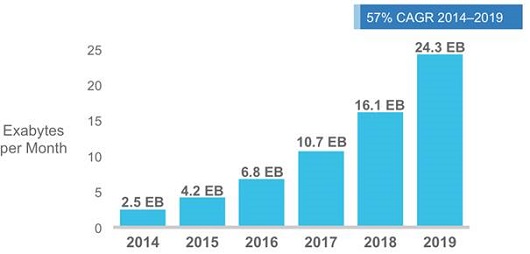Mobile Data Usage to Explode by 2019
February 5, 2015/
Unlimited talk and text is easy to find with just about any carrier. The only thing that really sets users and companies apart is data usage. In the last few years, data usage has grown quite a bit within the next five years, that growth is expected to increase tenfold.
This prediction is based on a report published by Cisco earlier this week. The report is titled Cisco’s Visual Networking Index (VNI) Global Mobile Data Traffic Forecast, and it is published every year based on various factors including technology growth rate and other factors. Of course, the report is mainly speculation and the numbers don’t mean a whole lot in the scheme of things. Still, the figures are interesting to see.
Here are some of the highlights:
Data Traffic Estimate
According to the report, mobile data traffic is expected to grow to an annual rate of 292 exabytes in 2019 (up from 30 exabytes in 2014). An exabyte, for those of you who aren’t familiar with the term, is equal to a billion gigabytes (GB). Globally in 2014, consumers used about 2.5 exabytes per month. Cisco has predicted that in 2019 that number will leap to 24.3 exabytes per month. This translates to a global average of about 11 gigabytes per person per month in 2019. Now, that might not seem like too high of an estimate–after all, plans with 10 GB per month aren’t too hard to find right now. However, according to the report the global average per user in 2014 was actually slightly under 2 GB per month. I guess it just goes to show how much money everyone is wasting on data they don’t necessarily need.Data Estimate by Region
So, since each country/region has different technology timelines, how does that translate per area? Fortunately, Cisco broke it down: According to the report, in 2014 alone almost half a billion new mobile devices and network connections were added. Extrapolating that to five years from now certainly makes things a little more plausible to me. Cisco included a mobile data traffic growth chart by region in the report. You can read it here by scrolling down to the first chart. While the report didn’t say exactly what formula they used to come up with these numbers, I would assume it is generated via the current rate of expansion and adoption of technology and mobile networks along with other factors. Some of those numbers look pretty insane to me–especially the Middle East and Central/Eastern Europe.Where is the Growth Coming From?
The next most logical question is: Where is all of this data growth coming from? Fierce Wireless wrote a pretty good article that highlighted some of the same points that I’ve made and suggested some of the following things, based on the report:- Mobile users will increase from 4.3 billion to 5.2 billion
- the Internet of Things movement will increase
- More mobile devices will be on the market
- M2M connections will increase
- LTE networks will become more common
- Mobile video will become more popular (and it uses more data)
What Does it Mean?
While these numbers are a little abstract and not really all that relevant for your average consumer, the predictions for where internet and wireless growth will be in the next five years is often used by companies to justify investment in new technologies and to strength spectrum and other parts of the wireless business. From a more personal standpoint, I tend to find reports like this interesting as it can be a good way to watch world trends and see where the wireless technology is headed. For example, the report talks extensively about wearables and how they are expected to impact the use of data and wireless spectrum. After reading this report, I expect that more companies will invest in this technology due to the positive forecast. It’s all connected in one way or another. If you want to take a peek at the full report, you can find it here. The report is super long, but at the very least there are a lot of graphs and charts that can give you a snapshot of each separate section.]]>
Posted in Mobile Data


